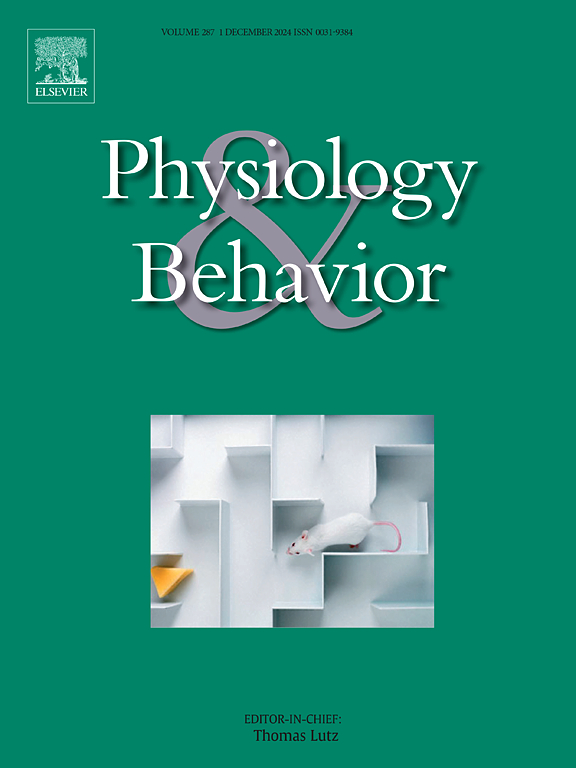慢性快速眼动睡眠剥夺和消失学习对恐惧条件反射大鼠冻结行为和BDNF、GSK-3β表达水平影响的性别差异
IF 2.5
3区 医学
Q2 BEHAVIORAL SCIENCES
引用次数: 0
摘要
恐惧条件反射是诱发啮齿动物创伤后应激障碍(PTSD)样模型最有用的方法之一,而灭绝学习是改善创伤后应激障碍样行为的有效方法。另一方面,快速眼动(REM)睡眠剥夺(SD)对行为功能,恐惧学习和记忆产生有害影响。本研究旨在评估灭绝学习、快速眼动SD或两者同时暴露的两性大鼠前额皮质脑源性神经营养因子(BDNF)和糖原合成酶激酶-3β (GSK-3β)的变化,以及ptsd样行为和其他行为功能。快速眼动SD观察14天(6h/d)。恐惧调节使用三次脚震(0.8 mA, 3 s)与声音(75 dB, 3 s)配对,间隔30 s。消除是通过播放三种声音(75分贝,间隔3秒,30秒)来完成的,没有脚震。结果显示,快速眼动睡眠在两性中都能降低冻结,对男性的影响更大。快速眼动SD联合消光对减少雄性冻结的效果更强。所有雄性的运动活动和饲养均减少。疼痛阈值仅在暴露于恐惧条件反射的男性中增加。在恐惧条件反射后,BDNF在两性中都有所下降,而灭绝则增加了它。在雄性中,GSK-3β没有变化,而在雌性中,恐惧条件反射使GSK-3β增加,消失使其恢复。总之,本研究显示除BDNF外,所有参数均存在显著的性别差异。有趣的是,研究结果表明,快速眼动SD在恢复男性ptsd样行为方面的作用与灭绝训练一样大。本文章由计算机程序翻译,如有差异,请以英文原文为准。
Sex differences in the effect of chronic REM sleep deprivation and extinction learning on freezing behavior and BDNF and GSK-3β expression levels in a rat model of fear conditioning
Fear conditioning is among the most useful methods to induce posttraumatic stress disorder (PTSD)-like model in rodents, while extinction learning is a useful method to ameliorate PTSD-like behaviors. On the other hand, rapid-eye movement (REM) sleep deprivation (SD) has deleterious effects on behavioral functions, and fear learning and memory. The present study aimed to assess PTSD-like behavior and other behavioral functions along with changes in brain-derived neurotrophic factor (BDNF) and glycogen synthase kinase-3beta (GSK-3β) in the prefrontal cortex of both sexes of rats exposed to extinction learning, REM SD, or both. REM SD was performed for 14 days (6h/d). Fear conditioning was done using three footshocks (0.8 mA, 3 s) paired with sound (75 dB, 3 s), with 30 s intervals. Extinction was done with broadcasting three sounds (75 dB, 3 s, 30 s intervals) without footshocks. The results showed REM SD decreased freezing in both sexes with greater effect in males. REM SD in combination with extinction showed stronger effect in the reduction of freezing in males. Locomotor activity and rearing in all males were decreased. Pain threshold was increased only in males exposed to fear conditioning. BDNF was decreased following fear conditioning in both sexes, while extinction increased it. GSK-3β was not changed in males, while in females, fear conditioning increased GSK-3β and extinction restored it. In conclusion, the present study revealed significant sex differences in all parameters except BDNF. Interestingly, the results showed that REM SD can restore PTSD-like behavior as much as extinction training in males.
求助全文
通过发布文献求助,成功后即可免费获取论文全文。
去求助
来源期刊

Physiology & Behavior
医学-行为科学
CiteScore
5.70
自引率
3.40%
发文量
274
审稿时长
47 days
期刊介绍:
Physiology & Behavior is aimed at the causal physiological mechanisms of behavior and its modulation by environmental factors. The journal invites original reports in the broad area of behavioral and cognitive neuroscience, in which at least one variable is physiological and the primary emphasis and theoretical context are behavioral. The range of subjects includes behavioral neuroendocrinology, psychoneuroimmunology, learning and memory, ingestion, social behavior, and studies related to the mechanisms of psychopathology. Contemporary reviews and theoretical articles are welcomed and the Editors invite such proposals from interested authors.
 求助内容:
求助内容: 应助结果提醒方式:
应助结果提醒方式:


